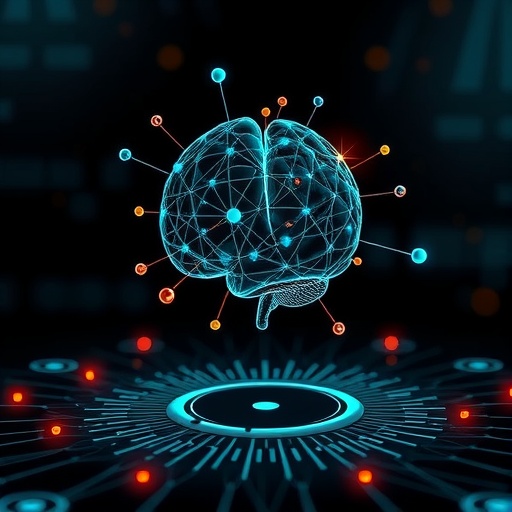In the rapidly evolving landscape of artificial intelligence, the application of large language models (LLMs) continues to redefine the boundaries of scientific research. A groundbreaking study, recently published in Nature Communications, showcases an innovative tool known as the Evidence Triangulator. This system employs cutting-edge LLMs to extract and synthesize causal evidence from an expansive array of scientific study designs, potentially revolutionizing how researchers conduct evidence synthesis and causal inference.
The Evidence Triangulator addresses a fundamental challenge in the realm of evidence-based science: integrating diverse streams of causal evidence generated from varying research designs. Traditional methods often struggle with synthesizing findings that arise from heterogeneous methodologies, including randomized controlled trials, observational studies, and quasi-experimental designs. This tool harnesses the interpretative and generative capacities of LLMs to bridge these gaps, offering a cohesive and automated approach to evidence aggregation.
At the heart of the Evidence Triangulator is an advanced natural language processing framework fine-tuned to rigorously parse scientific literature. Unlike conventional meta-analytical tools that rely heavily on structured data and manual curation, this system can ingest unstructured textual data from a vast spectrum of publications. It then identifies causal claims, extracts relevant variables, and assesses the methodological rigor implicit in each study design. This level of understanding allows the model not only to collect evidence but to synthesize it in a meaningful and causally coherent manner.
.adsslot_i85cFwnK6J{width:728px !important;height:90px !important;}
@media(max-width:1199px){ .adsslot_i85cFwnK6J{width:468px !important;height:60px !important;}
}
@media(max-width:767px){ .adsslot_i85cFwnK6J{width:320px !important;height:50px !important;}
}
ADVERTISEMENT
The research team behind this innovation, led by Shi, Zhao, and Chen, designed the Evidence Triangulator to function across multiple domains of scientific inquiry. Their approach demonstrates significant versatility, reflecting the model’s ability to interpret complex causal relationships irrespective of the disciplinary context or study framework. This generalizability marks a substantial advancement over domain-specific tools, which often face limitations when transferred across fields or study designs.
One of the profound advantages of this system lies in its ability to perform “evidence triangulation,” a process where independent lines of causal evidence converge to reinforce or refute hypotheses. In practical terms, the Evidence Triangulator operationalizes this concept by integrating data from experimental, observational, and quasi-experimental studies, automatically detecting consistencies or conflicts within the body of evidence. This functionality has profound implications for improving the reliability and robustness of scientific conclusions.
Moreover, the Evidence Triangulator incorporates mechanisms to evaluate the quality and bias inherent in various study designs. Given the known limitations and potential confounders associated with observational data versus randomized trials, the model contextualizes each piece of evidence relative to study type, sample size, and other methodological considerations. This analytical depth ensures that synthesized conclusions reflect a balanced appraisal of the evidence strength and are less susceptible to misleading inferences.
Beyond its methodological sophistication, the system’s capacity for scalable evidence synthesis enables researchers to process and interpret vast quantities of scientific literature swiftly. In an era where the volume of published research grows exponentially, tools like the Evidence Triangulator serve as critical aids in distilling meaningful insights from overwhelming data. This not only accelerates research timelines but also democratizes access to synthesized knowledge, enabling broader communities to engage with cutting-edge causal science.
The impact of the Evidence Triangulator also extends to policy-making and clinical decision-making. By generating synthesized causal evidence that is both comprehensive and interpretable, the system can inform evidence-based guidelines, health policy frameworks, and strategic interventions with greater confidence. This bridges the long-standing gap between fragmented research findings and actionable insights, enhancing the translation of scientific discovery into societal benefit.
Technically, the tool leverages transformer-based architectures characteristic of contemporary LLMs but introduces novel adaptations tailored for causal inference tasks. These adaptations include supervised fine-tuning on curated datasets annotated for causal language and study design features. The training pipeline emphasizes the ability to distinguish correlation from causation within complex text, a task traditionally challenging for automated systems. Additionally, the model integrates probabilistic reasoning modules to estimate confidence in extracted causal claims.
Another salient feature is the Evidence Triangulator’s interactive interface, which allows researchers to query causal hypotheses and visualize synthesized evidence across study designs dynamically. This transparency and user-centric design support hypothesis generation, critical appraisal, and collaborative interrogation of scientific claims. Furthermore, the interface fosters reproducibility by maintaining detailed provenance records of evidence sources and synthesis pathways.
Initial validation experiments reported by the authors demonstrate impressive performance metrics, with the system achieving high precision and recall in identifying causal statements across diverse literature samples. Moreover, comparative analyses indicate that the Evidence Triangulator surpasses existing automated tools in both extraction accuracy and synthesis coherence. Importantly, expert reviewers confirmed the validity of the synthesized conclusions, underscoring the system’s practical utility.
While the Evidence Triangulator heralds a new paradigm in evidence synthesis, the authors acknowledge challenges and future directions. These include expanding the tool’s capacity to handle multilingual scientific texts, enhancing the interpretability of causal inference mechanisms, and integrating real-world evidence from clinical registries and databases. Additionally, ongoing refinement aims to mitigate any biases that may be inadvertently encoded within training data, ensuring equitable and robust evidence processing.
The advent of such intelligent systems underscores a broader trend in scientific research: the fusion of artificial intelligence with methodological rigor to tackle complex, multidisciplinary problems. By embodying principles of transparency, scalability, and methodological diversity, the Evidence Triangulator exemplifies how AI can augment human expertise rather than replace it, fostering a collaborative and nuanced approach to scientific discovery.
In conclusion, the Evidence Triangulator represents a transformative advancement that leverages the power of large language models to navigate and synthesize the intricate landscape of causal evidence across study designs. As this technology matures, it holds the potential to accelerate the pace of discovery, enhance the reliability of causal claims, and ultimately support better decision-making in science and policy. The impact of this work will likely resonate across disciplines, ushering in a new era of evidence synthesis powered by AI intelligence.
Subject of Research: Using large language models to extract and synthesize causal evidence across diverse scientific study designs.
Article Title: Evidence triangulator: using large language models to extract and synthesize causal evidence across study designs.
Article References:
Shi, X., Zhao, W., Chen, T. et al. Evidence triangulator: using large language models to extract and synthesize causal evidence across study designs. Nat Commun 16, 7355 (2025). https://doi.org/10.1038/s41467-025-62783-x
Image Credits: AI Generated
Tags: AI in scientific researchautomated evidence aggregationbridging gaps in evidence-based sciencecausal evidence synthesiscausal inference advancementsEvidence Triangulator toolintegrating diverse research designslarge language models applicationmeta-analysis innovationsnatural language processing in researchovercoming methodological challengesunstructured data analysis in science





